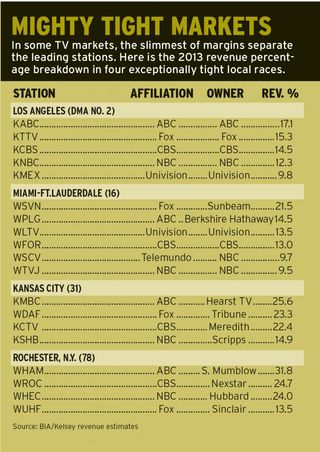Local TV’s Battle Royal

Related: Vote For The Most Competitive Local TV Market
If TV station general managers, news directors and sales managers are to be believed, there are around 200 most-competitive markets in the U.S. Neck-deep in the local news and ad sales battles each day, the station executives understandably believe their market may just be the one with the most torrid competition across Nielsen’s 210 designated market areas (DMAs).
A small minority of markets feature, in local TV parlance, a blowtorch station that simply leaves scorched earth in its wake. WBIR is a monster in Knoxville, Tenn. KYTV Springfield (Mo.) and WAFB Baton Rouge (La.) nearly double the nearest station in revenue, according to BIA/Kelsey. WBTW Florence-Myrtle Beach (S.C.) and KELO Sioux Falls (S.D.) do even better than that.
The vast majority of markets have a more level playing field, while a small handful feature a landscape where just a few percentage points separate the top from the bottom in revenue. Several factors go into a TV market being ridiculously competitive: the substantial presence of Spanish language viewers, a strong Fox station that goes toe to toe with the traditional Big Three, an independent or junior network affiliate that siphons off ratings points from the bigger boys, a determined new owner, the presence of severe weather, and perhaps even a local cable news channel keeping the broadcasters on their toes.
There are the ebbs and flows of networks’ prime and their effect on station programming, including late news. During NBC’s long prime slump, numerous NBC affiliated market leaders saw their advantage wither—especially as the local CBS rode the network’s prime momentum to ratings gains.
No Right Answer, No Wrong Answer
Polling over a dozen veteran broadcasters on the topic of competitive markets elicits about a dozen different answers. Yet some cities—including Los Angeles, Houston and Seattle—popped up more than others. Houston scored on several factors: a powerhouse in KHOU, acquired by massive Gannett; a robust network-owned station in KTRK; and a rightin- the-mix No. 3 in Graham Holdings’ KPRC, not to mention a crackerjack Univision station doing a double-digit percentage of market revenue.
Broadcasting & Cable Newsletter
The smarter way to stay on top of broadcasting and cable industry. Sign up below
“No one’s ever been able to pull away from the pack,” says one group leader.
Some cited Seattle for a proud news tradition and motivated new owners with enviable scale. NBC affiliate KING, acquired by Gannett in its Belo deal, was the revenue leader in 2013, according to BIA/Kelsey, with nearly 25% of the broadcast spend—two points ahead of KOMO. Formerly part of Seattle-based Fisher, KOMO was acquired by Sinclair last year. Cox and Tribune are players in the Seattle news market too.
KING benefits from, among other things, a strong legacy, the scale of Gannett and the expanded reach via sister independent KONG and Northwest Cable News.
“Those are aggressive news organizations in that market,” says one consultant. “I think the ratings indicate that it’s getting more aggressive and more competitive.”
All Shook Up
If a massive new owner is a double factor in Seattle, it’s a triple threat in Memphis. Tribune acquired leader WREG, Cox is getting Foxaligned WHBQ in a swap with Fox Television Stations and Nexstar has spent millions on a total makeover—building, image, talent—for longtime weak sibling WATN. Toss in powerful Raycom NBC affiliate WMC, and multiple sources say Memphis bears consideration.
Some DMAs get named because they’re growth markets where people consume loads of television—factors that put Pittsburgh on multiple ballots. “Legendarily competitive,” is how one veteran described DMA No. 23, which features Cox, Hearst TV and CBS-owned stations. In other markets, more challenging forces—an ailing economy, a populace that’s more into Netflix and mobile video than linear television—make the ratings gains that much more scarce.
Tech-savvy residents in San Francisco and Boston, along with a mix of well-heeled network operators and independent broadcasters taking delight in beating the O&Os, make those particularly difficult markets to steal a ratings point in. Toss in the wide array of rich media options available in Top 10 markets, and stations need to work doubly hard to stand out. “Because of low viewing levels from signon to sign-off, they’re fighting for scraps,” says Bill Hague, Frank N. Magid senior VP.
Small Markets, Small Advantage
But while local people meters tend to make races that much tighter, the extremely close races are not limited to the Top 20—or even the Top 100—markets. La Crosse-Eau Claire (Wis.) has three stations, led by WXOW, within 2.3% of each other in terms of revenue, says BIA/Kelsey, with the fourth not far off the pace. (BIA/Kelsey’s annual revenue figures are estimates, and station leaders at times take issue with the numbers.) Reno has three extraordinarily tightly clustered competitors, while Rockford, Ill., has no fewer than four. One group leader described No. 135 Rockford— where the owners are Gray, Quincy, Nexstar and closely aligned Mission—as a whole lot of work for not that much revenue. “Everyone’s fighting for what’s left on the bone,” he says. “Hell, they’re digging into the marrow.”
DMA No. 2 received a number of mentions, not as much for the tight race in Los Angeles—KABC is the longtime leader— but for the might of its owners, the vast array of stations broadcasting in both English and Spanish, the challenges of a local people meter market and the transient nature of the population. “It’s terribly tough there,” says Ed Ansin, Sunbeam Television owner. “The ratings points are so scarce.”
Others single out Dallas—O&Os, independents, Spanish-language powers—while some cast their votes for Louisville. DMA No. 49 has one of the more robust Fox affiliates nationwide in WDRB, and less than five percentage points separate No. 1 WLKY from No. 3 WHAS in terms of ’13 revenue. “It’s a horse race,” says one group news director, who notes the ample resources of WDRB parent Block Communications.
Still others cite Kansas City, where just two percentage points separated leader KMBC from No. 3 KCTV in 2013, with Fox affiliate WDAF sitting in the middle. Throw in Scripps’ fully engaged KSHB, which slotted Hearst TV vet Brian Bracco as GM late in 2012, and it’s a steel-cage match every day. “It’s as close as you can get,” says Bill Carroll, VP/director of programming at Katz Television Group.
New Owner, New Dynamic
Another key factor in the competitive landscape is a new owner with money to spend. Sinclair has doubled down in some news markets, including Cincinnati (its WKRC and Scripps’ flagship WCPO fight it out every day), Salt Lake City and Columbus, where a locally owned, family company (Dispatch powerhouse WBNS) gets increased competition from mega-scale Sinclair and Media General.
“Sinclair has done a helluva job investing in news product,” says a rival in Columbus, “and helping raise the overall game in the marketplace.”

Amidst all the consolidation in local broadcast the past few years, new owners are increasingly changing the dynamic. “When a station has been underperforming and a big group comes in—especially one where news is a priority—they’re gonna make a splash,” says Katz’s Carroll.
Other endorsements come in for Chicago and Minneapolis (“The legacy of competitiveness and the quality of the product,” says Nexstar president/CEO Perry Sook of the pair), and South Bend, where Schurz senior VP Marci Burdick has a front-row seat for the action. Schurz flagship WSBT is neck and neck with Gray’s WNDU, and Weigel’s WBND made things more interesting by building a news operation in 2011. “Pick a book, pick a demo, pick a show,” Burdick says. “It could be us or Gray.”
If You Can’t Stand the Heat…
Yet one market emerges with the most checks on its list of mega-competition factors. It has a ridiculously strong Fox affiliate with a distinctive brand cranking out a scary 55 hours of news a week. It has a pair of network owned stations and two affiliates owned by vastly wealthy individuals with sterling business reputations—and one with local roots. It has crime, politics and the possibility of severe weather, at least around this time of year.
Add an enormous Spanish-language base—nearly half the residents claim Hispanic origin, and the local Univision and Telemundo stations are right smack in the mix with the general market broadcasters—and the most competitive title goes to…Miami. And with these factors at play, it’s no wonder the stations are always driven to succeed, an effort that brings out the best in all parties. Dave Boylan was a general manager in Los Angeles and Tampa, among other markets, and spent a decade atop WPLG Miami. He stepped down a year ago, but the day-to-day television battle continues to inspire.
“Running a station in any market is extraordinarily tough and demanding,” he says. “But running a station in Miami really requires every muscle group imaginable.”
BETTER BRING YOUR ‘A’ GAME IN AN ‘A’ MARKET
TV markets these days are either hot or they’re not. The hot markets attract the attention of talent that wishes to ply its trade against the best, and of station buyers looking to secure battle-tested, blue chip assets in a still hot, scale-minded local broadcast landscape.
Increased competition is good for everyone—good for the rival stations, and most definitely good for the viewers. Lightweight stories don’t fly in an ‘A’ market. Savvy promos cut through the dense media thicket. Innovation wins the day in sales or digital—initiatives that are incubated locally, and often shared throughout the larger group.
Brian Lawlor, senior VP at Scripps, mentions Tampa and Phoenix as among the most competitive TV markets in his group. Scripps recently tapped Nick Nicholson, a veteran Phoenix GM, to run WFTS Tampa. “If you work in a tough market, you’re battle tested,” says Lawlor. “When Nick arrives in Tampa, I know he’ll be able to compete, because he’s done so in a complex market.”
Trina Robinson covers consumer issues for WTVJ Miami, but when there’s breaking news, it’s all hands on deck. That’s way more often than with her previous positions in Philadelphia and Orlando, among other markets. “It’s fun, it’s exciting, and no day is ever the same,” Robinson says. “We keep the studio hot all day.”
Michael Malone is content director at B+C and Multichannel News. He joined B+C in 2005 and has covered network programming, including entertainment, news and sports on broadcast, cable and streaming; and local broadcast television, including writing the "Local News Close-Up" market profiles. He also hosted the podcasts "Busted Pilot" and "Series Business." His journalism has also appeared in The New York Times, The L.A. Times, The Boston Globe and New York magazine.










